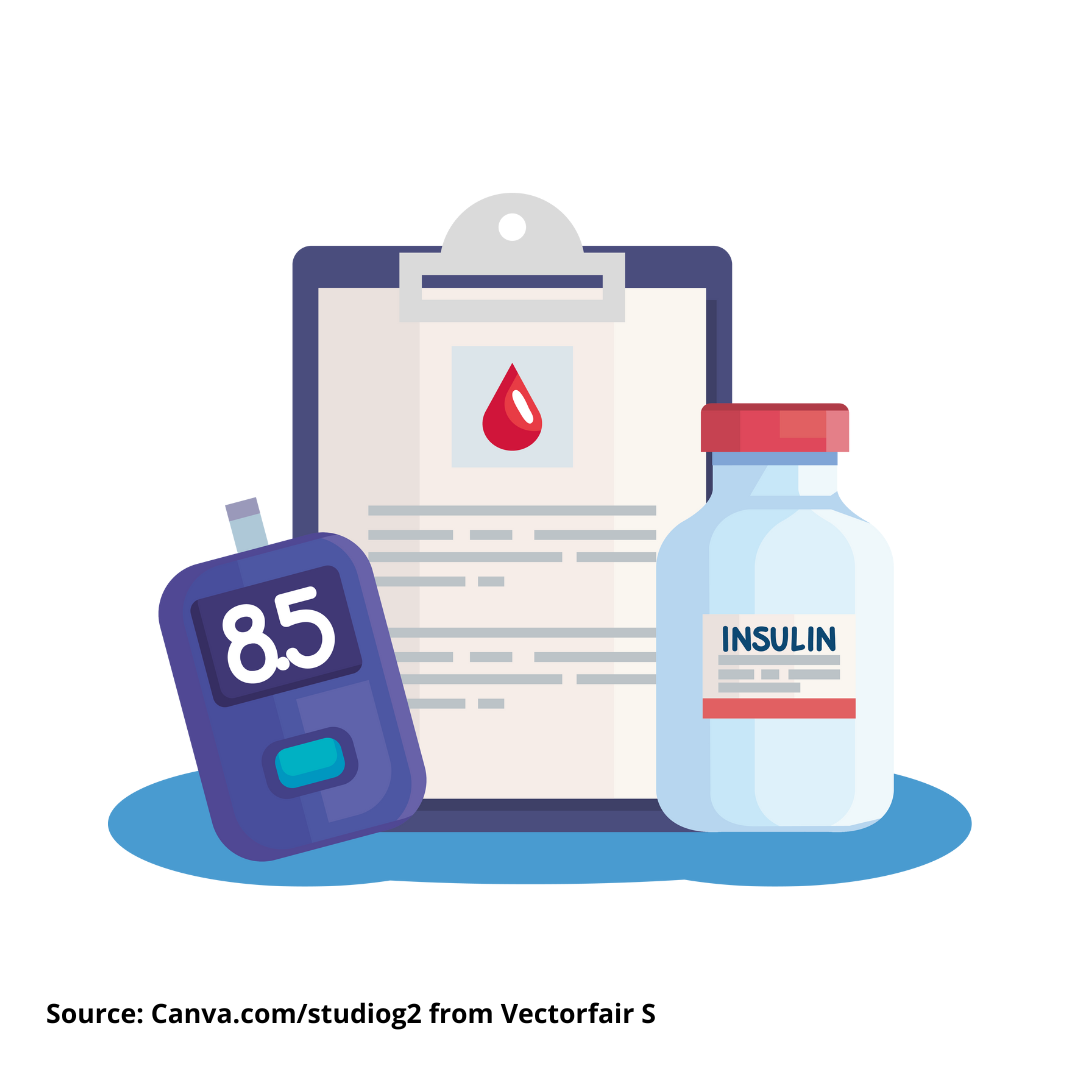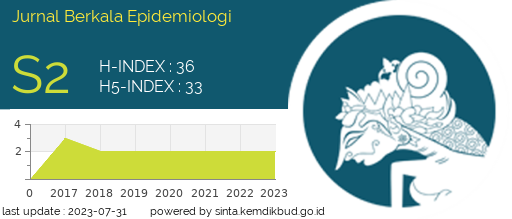ANALYSIS DETERMINANTS OF TYPE 2 DIABETES MELLITUS: A CASE CONTROL STUDY
Analisis Determinan Kejadian Diabetes Mellitus Tipe 2: Studi Case Control

Downloads
Background: Type 2 Diabetes Mellitus (type 2 DM) is a chronic disease in adults due to the body's resistance to insulin. Purpose: This study aims to analyze the determinants of the incidence of type 2 DM. Methods: The study design was a case-control study. The case population in this study was patients with type 2 DM who had been diagnosed by doctors based on data available in the medical records of Bintang Bayu Health Center. In contrast, the control population was patients who did not suffer from type 2 DM. The study's sample size was 138 people, with a ratio of cases to controls of 1:2. The case group consisted of 46 people, and the control group comprised 92 people. The sampling technique used was nonprobability sampling, namely, consecutive sampling. Questionnaire distribution was the primary method of data collection. The frequency distribution of each variable was calculated before analyzing the data using Chi-square and logistic regression. Results: Diet (p=0.001; OR=4.7; 2.231–10.154), knowledge (p=0.033; OR=2.3; 1.129–4.785), physical activity p = 0.010; OR = 2.8; 1.342 – 6.032), hypertension (p=<0.001; OR=4.9; 2.089–11.784) were significant to the incidence of type 2 DM. The most dominant variable was hypertension, p=<0.001; OR=7.3 (2.581-20.680). Conclusions: Poor diet, poor knowledge, light physical activity, and hypertension were significant factors in the incidence of type 2 DM.
Yan Y, Wu T, Zhang M, Li C, Liu Q, Li F. Prevalence, awareness and control of type 2 diabetes mellitus and risk factors in Chinese elderly population. BMC Public Health. 2022;22(1):1–6.
Ismail L, Materwala H, Al Kaabi J. Association of risk factors with type 2 diabetes: A systematic review. Comput Struct Biotechnol J. 2021;19:1759–85.
Dika H, Deogratias M, Byamungu D, Marwa K, Kapesa A, Mwita S. Practice and knowledge on type 2 diabetes mellitus risk factors among office workers in Mwanza City, Tanzania. East African Heal Res J. 2023;7(1):81.
Cole JB, Florez JC. Genetics of diabetes mellitus and diabetes complications. Nat Rev Nephrol. 2020;16(7):377–90.
Mezil SA, Abed BA. Complication of diabetes mellitus. Ann Rom Soc Cell Biol. 2021;1546–56.
Binh MNT, My DDT, Lan ANT, Cong HN, Xuan HN, Thu HHT, et al. Risk factors related to diabetic retinopathy in Vietnamese patients with type 2 diabetes mellitus. Endocr Metab Sci. 2023;13:100145.
Sun H, Saeedi P, Karuranga S, Pinkepank M, Ogurtsova K, Duncan BB, et al. IDF Diabetes Atlas: Global, regional and country-level diabetes prevalence estimates for 2021 and projections for 2045. Diabetes Res Clin Pract. 2022;183:109119.
WHO. Diabetes. 2024.
IDF. IDF Diabetes Atlas, Indonesia Diabetes Report 2000-2045. 2025.
Ministry of Health of the Republic of Indonesia. 2023 Indonesian Health Survey Report. 2023.
Serdang Bedagai Regency Health Office. Health profile of Serdang Bedagai Regency. 2023.
Magriplis E, Panagiotakos D, Papakonstantinou E, Mitsopoulou AV, Karageorgou D, Dimakopoulos I, et al. Prevalence of type 2 diabetes mellitus in a representative sample of Greek adults and its association with modifiable risk factors: results from the Hellenic National Nutrition and Health Survey. Public Health. 2021;197:75–82.
Alfaqeeh M, Alfian SD, Abdulah R. Factors associated with diabetes mellitus among adults: Findings from the Indonesian Family Life Survey-5. Endocr Metab Sci. 2024;14:100161.
Farah R, Alhajahjeh A, Al-Farahid O, Abuzaid H, Hyassat D, Al-Khuraisat G, et al. Risk factors for chronic kidney disease in middle eastern patients with type 2 diabetes mellitus: A cross-sectional study using the KDIGO classification. J Diabetes Complications. 2024;38(5):108740.
Ma XM, Li KX, Chen ZQ, Wu CM, Liao WZ, Guo XG. Impact of age, sex, and thyroid autoimmunity on the association between selenium intake and type 2 diabetes mellitus. BMC Public Health. 2024;24(1):743.
Asyumdah A, Yuniastuti A, Kuswardinah A. Analysis of food consumption patterns with the incidence of type 2 diabetes mellitus in Kulon Progo DI, Yogyakarta. Public Heal Perspect J. 2020;5(2).
Almutairi OM, Alhomaid TA, Alshuaibi AM, Alahmad RMA, Al Mardhamah NH, Alamri T, et al. The influence of eating habits on type 2 diabetes in Saudi Arabia: a systematic review. Cureus. 2023;15(7).
Nabila KA, Kusumawati M, Megawati G. Knowledge and perception of diabetes mellitus among patients with type 2 diabetes mellitus in five public health centers in Karawang, West Java, Indonesia. Althea Med J. 2022;9(1):12–8.
Ferreira PL, Morais C, Pimenta R, Ribeiro I, Amorim I, Alves SM, et al. Knowledge about type 2 diabetes: its impact for future management. Front Public Heal. 2024;12:1328001.
Shawahna R, Samaro S, Ahmad Z. Knowledge, attitude, and practice of patients with type 2 diabetes mellitus with regard to their disease: a cross-sectional study among Palestinians of the West Bank. BMC Public Health. 2021;21:1–13.
Al-Wagdi BE, Al-Hanawi MK. Knowledge, attitude and practice toward diabetes among the public in the Kingdom of Saudi Arabia: a cross-sectional study. Front public Heal. 2024;12:1326675.
Bilondi SS, Noghabi AD, Aalami H. The relationship between illness perception and medication adherence in patients with diabetes mellitus type II: illness perception and medication adherence. J Prev Med Hyg. 2022;62(4):E966.
Eshete A, Getye B, Aynaddis G, Tilaye B, Mekonnen E, Taye B, et al. Association between illness perception and medication adherence in patients with diabetes mellitus in North Shoa, Zone: cross-sectional study. Front Public Heal. 2023;11:1214725.
Syeda USA, Battillo D, Visaria A, Malin SK. The importance of exercise for glycemic control in type 2 diabetes. Am J Med Open. 2023;9:100031.
Jayedi A, Zargar MS, Emadi A, Aune D. Walking speed and the risk of type 2 diabetes: a systematic review and meta-analysis. Br J Sports Med. 2024;58(6):334–42.
Hezam AAM, Shaghdar HBM, Chen L. The connection between hypertension and diabetes and their role in heart and kidney disease development. J Res Med Sci Off J Isfahan Univ Med Sci. 2024;29.
Alsaadon H, Afroz A, Karim A, Habib SH, Alramadan MJ, Billah B, et al. Hypertension and its related factors among patients with type 2 diabetes mellitus–a multi-hospital study in Bangladesh. BMC Public Health. 2022;22(1):198.
Olamoyegun MA, Alare K, Afolabi SA, Aderinto N, Adeyemi T. A systematic review and meta-analysis of the prevalence and risk factors of type 2 diabetes mellitus in Nigeria. Clin Diabetes Endocrinol. 2024;10(1):1–13.
Hussein WN, Mohammed ZM, Mohammed AN. Identifying risk factors associated with type 2 diabetes based on data analysis. Meas Sensors. 2022;24:100543.
- Every manuscript submitted to must observe the policy and terms set by the Jurnal Berkala Epidemiologi
- Publication rights to manuscript content published by the Jurnal Berkala Epidemiologi is owned by the journal with the consent and approval of the author(s) concerned. (download copyright agreement)
- Complete texts of electronically published manuscripts can be accessed free of charge if used for educational and research purposes according to copyright regulations.

JBE by Universitas Airlangga is licensed under a Creative Commons Attribution-ShareAlike 4.0 International License.























